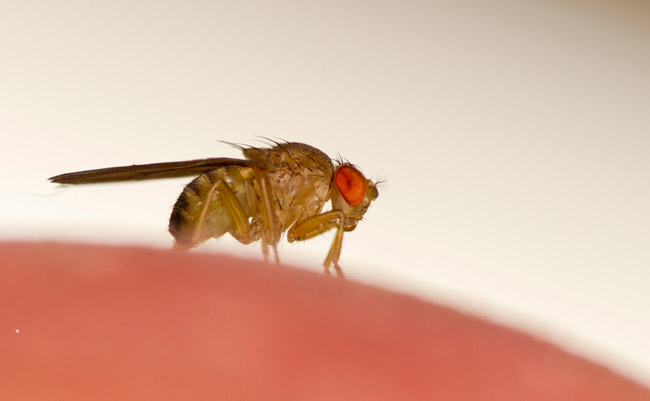Vinegar Flies
By Chris Williams on January 10, 2014.
 Question
Question
I recently had brunch at an upscale restaurant known for excellent food. The presentation was stunning, service impeccable, and the food was prepared perfectly. We finished our main courses and went to the dessert table to sample the copious offering of fruits, cakes, pies, tarts, and many other amazing treats. My son noticed several small flies hovering around the strawberries and bananas displayed on a silver tray. Nothing appeared dirty or out of place. What do you think they were and should we be concerned? We didn’t mention it to our waiter, but my daughter thought it was gross.
Answer
What you were seeing was most likely the vinegar or pumice fly, commonly called “fruit flies.” These small flies are common worldwide. Vinegar flies are seen in bars, markets, homes, restaurants, or any place rotting fruits or vegetables are found. Populations of this fly can grow very quickly if conducive conditions exist. Most species have either red or black eyes, are about 1/8 inch long, with a dull tan-to-brown-colored head and thorax, and a striped abdomen. Under ideal conditions, the life cycle takes from 8 to 14 days from egg to adult ready to mate.
These small flies can live for about two weeks, and females can lay more than 500 eggs during this time. Eggs are laid on rotting organic material. They prefer fruits and other liquids that become acidic as they decompose, like vinegar. One lemon peel or wine cork can produce thousands of flies. Tiny maggots, visible with the naked eye, feed on the rotting organic material.
Prior to pupation, the maggots leave the moist food source in search of a drier location. The pupae are small, brown, and seed-like. Adult vinegar flies flit around, mating and laying eggs, and this involves landing on rotting food, resting on questionable surfaces, and the potential spread of disease organisms. Pathogens such as disease bacteria including salmonella may cause diarrhea or other intestinal discomfort if contamination with food being served takes place. Luckily this is not often documented, but each year millions of Americans come down with “stomach bugs” and similar ailments that may in fact be related to contamination from flies of some kind.
When it comes to vinegar flies, sanitation procedures are critical. Thorough removal of all organic material in prep, cooking, clean-up, storage, and disposal areas, including mop equipment, drains, flooring and exterior trash facilities is mandatory. Most businesses recognize this and take steps to manage fruit fly populations. Even the most extensive management programs still allow for occasional invaders, pests brought in on produce, and other factors beyond the control of Pest Control Professionals. Sanitation and consideration of all the factors involved will result in the least possible effects from flies of all kinds.